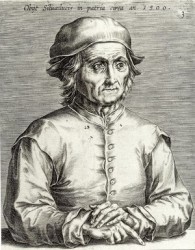
Chipps Smith 1990/91
“Netherlandish artists and art in Renaissance Nuremberg” (Jeffrey Chipps Smith) 1990/91
[in: Simiolus, vol. 20 (1990/91), nr. 2-3, pp. 153-167]
In this article the author discusses some artists from the Low Countries who were active in Nuremberg in the sixteenth century. He also gives information about some local patricians who collected Dutch and Flemish works of art. One of these collectors was Paulus Praun (1548-1616). He is said to have possessed a Bosch painting that he had acquired from the heirs of Albrecht Dürer. Dürer himself had acquired the painting during his trip through the Netherlands. In the eighteenth-century catalogue of C.T. de Murr the painting is called un incendie. So it was probably a hell scene or a burning landschape [165].
According to the same catalogue Praun also possessed a Bosch drawing with the title Death of a chemist or of a charlatan doctor. Chipps Smith wonders whether this drawing can be identified as the Death of a miser drawing after Bosch which is now in the Louvre. De Murr was not sure about the subject of the drawing and he mentioned that the drawing was made by Jerôme Bos d’Anvers: the backside of the Louvre drawing shows the old inscription Jeronimus Bos van Antwerpen. That the Louvre drawing was once owned by Praun becomes even more probable because it once belonged to prince Nikolaus Esterhàzy (1765-1833, Vienna). In the beginning of the eighteenth century this prince bought a large collection of works of art (especially drawings) from the Nuremberg art dealer Johann Friedrich Frauenholz, who – together with a partner – had acquired the Praun collection some years before. In 1870 the Esterhàzy collection was moved to Budapest but several pieces were sold and are in St. Petersburg, Vienna, London and Paris today [165-166].
For the eighteenth-century catalogue, see C.T. de Murr, Description du cabinet de Monsieur Paul de Praun à Nuremberg, Nuremberg, 1797 [156, note 14].
[explicit]